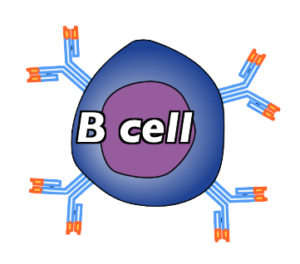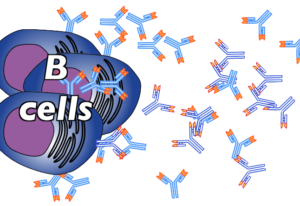1. How the Cell Mobilizes to Release Antibodies
When you fight off a virus, your immune system produces antibodies. Antibodies are virus-killing proteins that are made by white blood cells called B cells, which secrete them by the millions into the bloodstream. As B cells produce antibodies, their appearance changes. Their cytoplasm becomes filled with endoplasmic reticulum (ER). There’s also a lot of Golgi Apparatus.
|
|
|
What’s going on?
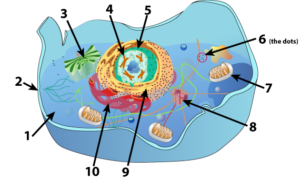 The ER is a vast internal network of channels separated from the rest of the cytoplasm by an internal plasma membrane. The Golgi is similar, except that instead of channels, the Golgi forms a series of flattened, elongated sacs, also bound by membranes. In the diagram at right, which we’ve extensively studied in previous tutorials, the ER is at 9 and 10, while the Golgi is shown at 3.
The ER is a vast internal network of channels separated from the rest of the cytoplasm by an internal plasma membrane. The Golgi is similar, except that instead of channels, the Golgi forms a series of flattened, elongated sacs, also bound by membranes. In the diagram at right, which we’ve extensively studied in previous tutorials, the ER is at 9 and 10, while the Golgi is shown at 3.
To understand the way that the ER, Golgi, and other organelles cooperate in various cell processes, we’re going to shift to a much simpler diagram that only includes the parts we’re interested in.
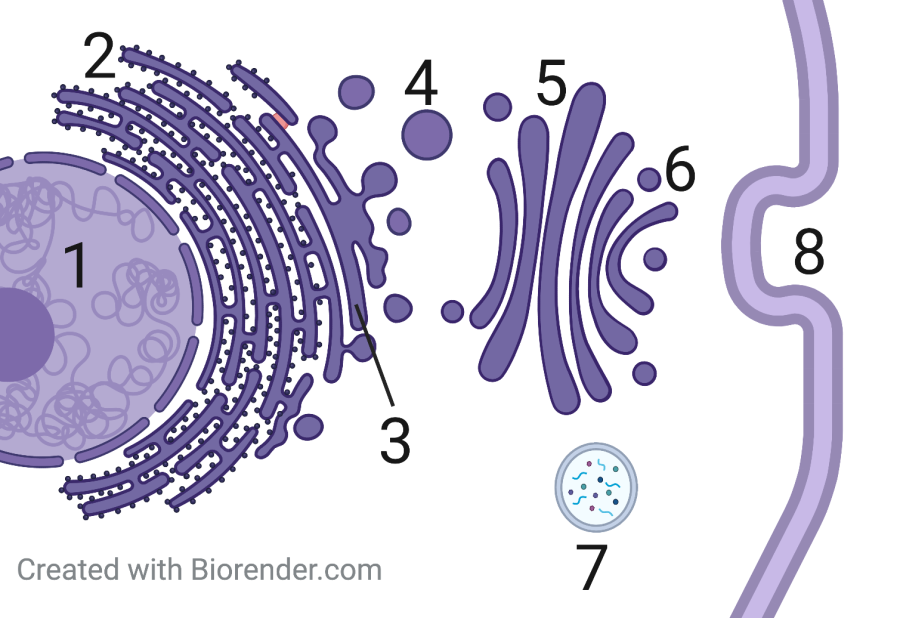
In the diagram to the left, the nucleus is shown at 1. The endoplasmic reticulum is at 2 and 3. The Golgi is at 5.
The left side of the ER is covered by many ribosomes, which are shown as dots in this illustration. Ribosomes are the cell’s protein factories: they’ll make any protein that they’re told to make, based on instructions they receive from the nucleus. ER with ribosomes is called Rough ER. ER without ribosomes is smooth ER, and we’ll discuss it more below.
Antibodies, like all proteins that will be exported out of the cell, are made at the rough ER (2). As the antibody is made, it gets put into the channels of the ER. It then moves to the Smooth ER (3). In the same way that bubbles can form from a soap film, the smooth ER will bud off a bubble of membrane, also known as a vesicle (shown at 4). A vesicle is a name we give to any small, membrane-bound sac that’s transporting substances from one area of the cell to another.
This vesicle, containing the antibody, will merge with the Golgi Apparatus (5). The Golgi has enzymes that modify the antibody, getting the antibody into the exact form it will need to be in to bind with and help to neutralize the virus. When the Golgi is done, it buds off another vesicle (6). This vesicle will fuse with the cell membrane (8). As it does, the antibody will be dumped into the cell’s exterior. In this case, that means the bloodstream. The antibody (along with millions of other identical antibodies) will now float around in the blood and, hopefully, bind with the virus, helping to neutralize it (Note, in case you’re worried, number 7 —the lysosome — doesn’t play a role in antibody production).
2. Checking Understanding: The Endomembrane System
Let’s just work with this diagram a bit to make sure that you’re understanding it.
[qwiz random = “true” qrecord_id=”sciencemusicvideosMeister1961-Endomembrane System CFU (2.0)”]
[h]Endomembrane quiz 1
[i]
[q]Which number is pointing to the nucleus?
[textentry single_char=”true”]
[c]MQ ==[Qq]
[f]WWVzLiBUaGUgbnVjbGV1cywgdGhlIGNlbGwmIzgyMTc7cyBjb250cm9sIGNlbnRlciwgaXMgYXQgbnVtYmVyIDE=[Qq]
[c]Kg==[Qq]
[f]Tm8uIEZpbmQgdGhlIHN0cnVjdHVyZSB0aGF0JiM4MjE3O3MgY2xvc2VzdCB0byB0aGUgY2VudGVyIG9mIHRoZSBjZWxsIChmdXJ0aGVzdCBmcm9tIHRoZSBtZW1icmFuZS4=
Cg==[Qq]
[q]Which number is pointing to where ribosomes are going to make the antibody that’s (hopefully) going to fight off the invading virus?
[textentry single_char=”true”]
[c]Mg ==[Qq]
[f]WWVzLiAmIzgyMjA7MiYjODIyMTsgaXMgdGhlIHJvdWdoIEVSLCB3aGljaCBpcyB3aGVyZSByaWJvc29tZXMgYXR0YWNoZWQgdG8gdGhlIEVSIGFyZSBtYWtpbmcgcHJvdGVpbnMu[Qq]
[c]Kg==[Qq]
[f]Tm8uwqBZb3UmIzgyMTc7cmUgbG9va2luZyBmb3IgdGhlIHJvdWdoIEVSLiBGaW5kIHJpYm9zb21lcyAoYmxhY2sgZG90cykgYXR0YWNoZWQgdG8gbWVtYnJhbmUu
Cg==[Qq]
[q]After the antibody is made, it’s going to be enclosed within a bubble of membrane. Such a bubble of membrane is also known as a vesicle. Where is the membrane that’s going to make up that vesicle going to be made?
[textentry single_char=”true”]
[c]Mw ==[Qq]
[f]WWVzLiAmIzgyMjA7MyYjODIyMTsgaXMgdGhlIHNtb290aMKgRVIsIHdoaWNoIGlzIHdoZXJlwqBtZW1icmFuZSAoYW5kIG90aGVyIGxpcGlkcykgYXJlIHN5bnRoZXNpemVkLg==[Qq]
[c]Kg==[Qq]
[f]Tm8uIFlvdSYjODIxNztyZSBsb29raW5nIGZvciB0aGUgc21vb3RoIEVSLCB3aGljaCBpcyBhIG5ldHdvcmsgb2YgbWVtYnJhbmVzIGp1c3Qgb3V0c2lkZSBvZiB0aGUgcm91Z2ggRVIsIGFuZCB3aGljaCBsYWNrcyByaWJvc29tZXMu
Cg==[Qq]
[q]Which numbered part indicates a vesicle that’s going to transport the antibody from the ER to the Golgi?
[textentry single_char=”true”]
[c]NA ==[Qq]
[f]WWVzLiAmIzgyMjA7NCYjODIyMTsgaXPCoGEgdmVzaWNsZSwgYSBidWJibGUgb2YgbWVtYnJhbmUsIHRoYXQmIzgyMTc7cyB0cmFuc3BvcnRpbmcgb3VyIGRldmVsb3BpbmcgYW50aWJvZHkgZnJvbSB0aGUgRVIgdG8gdGhlIEdvbGdpIGFwcGFyYXR1cy4=[Qq]
[c]Kg==[Qq]
[f]Tm8uIExvb2sgZm9yIGEgc21hbGwgYnViYmxlIG9mIG1lbWJyYW5lIGluLWJldHdlZW4gdGhlIEVSIGFuZCB0aGUgR29sZ2ku
Cg==[Qq]
[q]The antibody is going to have to be modified and packaged for export before it can be released from the cell into the bloodstream. Which numbered part is where this modification and packaging is going to happen?
[textentry single_char=”true”]
[c]NQ ==[Qq]
[f]WWVzLiAmIzgyMjA7NSYjODIyMTsgaXMgdGhlIEdvbGdpIGFwcGFyYXR1cy4gV2l0aGluIHRoZXNlIGZsYXR0ZW5lZCBzYWNzIG9mIG1lbWJyYW5lLCBlbnp5bWVzIG1vZGlmeSBwcm90ZWlucyBhbmQgcHJlcGFyZSB0aGVtIGZvciBzaGlwcGluZyB0byB0aGVpciBmaW5hbCBkZXN0aW5hdGlvbi4=[Qq]
[c]Kg==[Qq]
[f]Tm8uIExvb2sgZm9yIHRoZSBzZXJpZXMgb2YgZmxhdHRlbmVkIHNhY3MgYmV0d2VlbiB0aGUgbWVtYnJhbmUgYW5kIHRoZSBFUi4=
Cg==[Qq]
[q]After modification of the protein, the Golgi will bud off a vesicle that will bring the antibody to the membrane for export from the cell. Which number shows a vesicle that’s budding off from the Golgi complex?
[textentry single_char=”true”]
[c]Ng ==[Qq]
[f]WWVzLiAmIzgyMjA7NiYjODIyMTsgc2hvd3MgYSB2ZXNpY2xlIHRoYXQmIzgyMTc7cyBidWRkaW5nIG9mZiBmcm9tIHRoZSBHb2xnaS4=[Qq]
[c]Kg==[Qq]
[f]Tm8uwqBGaW5kIHRoZSB2ZXNpY2xlIGp1c3Qgb3V0c2lkZSB0aGUgR29sZ2kgYm9keSwgaW4gYmV0d2VlbiB0aGUgR29sZ2kgYW5kIHRoZSBtZW1icmFuZSAoYW5kIGRvbiYjODIxNzt0IHBpY2sgIyA3KS4=
Cg==[Qq]
[q]To be exported from the cell, our antibody is going to be transported (within a vesicle) to the membrane. The vesicle will fuse with the membrane, and dump the antibody out of the cell (in this case, into the bloodstream). Which number shows a vesicle that’s fusing with the membrane, dumping its contents outside?
[textentry single_char=”true”]
[c]OA ==[Qq]
[f]WWVzLiAmIzgyMjA7OCYjODIyMTsgc2hvd3MgYSB2ZXNpY2xlIHRoYXQmIzgyMTc7cyBmdXNpbmcgd2l0aCB0aGUgbWVtYnJhbmUu[Qq]
[c]Kg==[Qq]
[f]Tm8uwqBGaW5kIHRoZSB2ZXNpY2xlIHRoYXQmIzgyMTc7cyBmdXNlZCB3aXRoIHRoZSBtZW1icmFuZSwgZm9ybWluZyBhIGtpbmQgb2YgcG9ja2V0IHdpdGhpbiB0aGUgbWVtYnJhbmUsIHdpdGggYXJyb3dzIGluZGljYXRpbmfCoHRoYXQgbWF0ZXJpYWxzIGFyZSBiZWluZyBkdW1wZWQgb3V0c2lkZSBvZiB0aGUgY2VsbC4=[Qq]
[x][restart]
[/qwiz]
3. Interactive reading: Introducing Lysosomes
[qwiz qrecord_id=”sciencemusicvideosMeister1961-I.R: Introducing Lysosomes (2.0)”]
[h]Interactive Reading: Introducing Lysosomes
[i]Consider the Amoeba, a eukaryotic, single-celled organism found in freshwater lakes and streams, where it preys on bacteria and scavenges small pieces of organic matter. In this tutorial, you’ll learn about how it uses lysosomes to digest its food.
[q topic = “info”]The process by which an amoeba engulfs its prey is called phagocytosis.
The process begins at “A”. The amoeba extends part of its membrane to surround its prey (2). The extension is called a pseudopod (“false foot”) and is shown at 1. In this same diagram, you can also see two other organelles. For our purposes, the most important of these is number 3: lysosome. The lysosome contains digestive enzymes which would be harmful to the cell if they were floating in the cytoplasm (because they would digest the cell). Click “next question” to continue.
[q]In “B” you can see what happens when the pseudopods surround the prey. At this point, the prey is enclosed in a food vacuole (5). In “C,” the lysosome fuses with the food vacuole. The enzymes in the lysosome attack the prey, breaking it down into simple monomers.
Which number is the lysosome?
[textentry single_char=”true”]
[c]Mw ==[Qq]
[f]WWVzLiAmIzgyMjA7MyYjODIyMTvCoGlzIHRoZSBseXNvc29tZQ==[Qq]
[c]Kg==[Qq]
[f]Tm8uwqBGaW5kIHRoZSB2ZXNpY2xlIHRoYXQmIzgyMTc7c8KgZ29pbmcgdG8gZnVzZSB3aXRoIHRoZSBpbmdlc3RlZCBmb29kLiBUaGF0JiM4MjE3O3MgdGhlIHBhcnQgdGhhdCYjODIxNztzIGZpbGxlZCB3aXRoIGRpZ2VzdGl2ZSBlbnp5bWVzLg==[Qq]
[q]Which number is a pseudopod?
[textentry single_char=”true”]
[c]MQ ==[Qq]
[f]WWVzLiAmIzgyMjA7MSYjODIyMTvCoGlzIHRoZcKgcHNldWRvcG9kLg==[Qq]
[c]Kg==[Qq]
[f]Tm8uwqBGaW5kIHRoZcKgZXh0ZW5zaW9uIG9mIHRoZSBtZW1icmFuZSB0aGF0JiM4MjE3O3MgYWJvdXQgdGhlIHN1cnJvdW5kIGFuZCBlbmd1bGYgdGhlIHByZXku[Qq]
[q]Which number is a food vacuole?
[textentry single_char=”true”]
[c]NQ ==[Qq]
[f]WWVzLiAmIzgyMjA7NSYjODIyMTvCoGlzIGHCoGZvb2QgdmFjdW9sZS4=[Qq]
[c]Kg==[Qq]
[f]Tm8uIEZpbmQgdGhlIG1lbWJyYW5lICYjODIyMDtidWJibGUmIzgyMjE7IChhY3R1YWxseSBhIGxhcmdlIHZlc2ljbGUpIHRoYXQgZm9ybXMgd2hlbiB0aGUgcHNldWRvcG9kcyBzdXJyb3VuZCB0aGUgcHJleS4=[Qq]
[q topic – “info”]In “C,” the lysosome (3) fuses with the food vacuole (5). The enzymes in the lysosome attack the prey, breaking it down into simple monomers. Number 4, by the way, is the nucleus, which is not directly involved in this process (though it did code for the enzymes that are in the lysosome).
Click “next question” to continue.
[q]In “D”, those monomers are released into the cytoplasm, where the cell can use them for food or energy. In “E” the lysosome has been inactivated. The food molecules are in the cytoplasm, and molecules or particles that can’t be digested are released from the cell.
Which letter shows the moment when the food vacuole and the lysosome have fused?
[textentry single_char=”true”]
[c]Yw ==[Qq]
[f]WWVzLiAmIzgyMjA7YyYjODIyMTsgc2hvd3MgYSBseXNvc29tZSB0aGF0IGhhcyBmdXNlZCB3aXRoIGEgZm9vZCB2YWN1b2xlLg==[Qq]
[c]Kg==[Qq]
[f]Tm8uIEZpbmQgdGhlIGZpcnN0IHN0YWdlIHdoZW4gdGhlIGZvb2QgdmFjdW9sZSAoNSkgYW5kIHRoZSBseXNvc29tZSAoMykgaGF2ZSBiZWNvbWUgb25lIG1lbWJyYW5lLWVuY2xvc2VkIGVudGl0eS4gWW91ciBhbnN3ZXIgd2lsbCBiZSBhIGxldHRlciAoYSwgYiwgYywgZCwgb3IgZSk=[Qq]
[q topic = “info”]So, now we know about lysosomes. But here’s a question. If the enzymes inside a lysosome can digest bacteria, they must be pretty dangerous. What I mean by that is that the same enzymes that could digest the proteins, carbohydrates, lipids, and nucleic acids in a bacterial cell could probably digest many of those same substances in a eukaryotic cell. How does the cell safely get those enzymes inside the lysosome? You’ll find your answer below.
[/qwiz]
4. Making Lysosomes
The hydrolytic enzymes in lysosomes are dangerous, and can’t be directly exposed to the cytoplasm (or else the cell would wind up digesting itself). In the diagram below, 7 represents a lysosome. What would have to happen for a cell to safely get one of these enzymes into a lysosome?
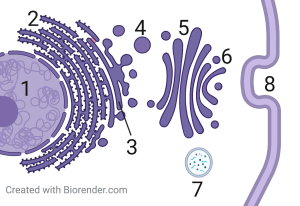
Take the following steps and put them into the correct order in the table below.
[qwiz style=”width: 600px !important;” qrecord_id=”sciencemusicvideosMeister1961-Putting Enzymes into Lysosomes (2.0)”]
[h] Putting hydrolytic enzymes into a lysosome
[q labels = “top”]
| Step One | ___________________________________________________________ |
| Step Two | ___________________________________________________________ |
| Step Three | ___________________________________________________________ |
| Step Four | ___________________________________________________________ |
| Step Five | ___________________________________________________________ |
[l]Enzyme goes to Golgi for modification and activation
[f*] Good!
[fx] No. Please try again.
[l]Golgi buds off a vesicle that goes to a lysosome.
[f*] Great!
[fx] No. Please try again.
[l]Instructions go from the nucleus to a ribosome
[f*] Great!
[fx] No, that’s not correct. Please try again.
[l]Ribosome makes the enzyme inside the rough ER
[f*] Correct!
[fx] No. Please try again.
[l]Smooth ER makes a vesicle containing the enzyme
[f*] Great!
[fx] No, that’s not correct. Please try again.
[/qwiz]
5. The Endomembrane System: The Whole Shebang
[qwiz random = “true” qrecord_id=”sciencemusicvideosMeister1961-Endomembrane System Quiz (2.0)”]
[h]The endomembrane system
[i]Use what you’ve learned above to identify the parts and function of the endomembrane system, as shown below.
[q]Which letter below is pointing to the nuclear membrane (also called the nuclear envelope)?
[textentry single_char=”true”]
[c]QQ ==[Qq]
[f]WWVzLiAmIzgyMjA7QSYjODIyMTvCoGlzwqBwb2ludGluZyB0byB0aGUgbnVjbGVhciBtZW1icmFuZS4=[Qq]
[c]Kg==[Qq]
[f]Tm8uwqBGaW5kIHRoZcKgbWVtYnJhbmUgdGhhdCYjODIxNztzIHN1cnJvdW5kaW5nIHRoZSBudWNsZXVzICh0b3dhcmRzIHRoZSBjZW50ZXIgb2YgdGhlIGNlbGwp
Cg==[Qq]
[q] Which letter below is pointing to a nuclear pore?
[textentry single_char=”true”]
[c]Qg ==[Qq]
[f]R3JlYXQgam9iLiAmIzgyMjA7QiYjODIyMTvCoGlzIHBvaW50aW5nIHRvIGEgbnVjbGVhciBwb3JlLg==[Qq]
[c]Kg==[Qq]
[f]Tm8uIFRvIGZpbmQgYSBudWNsZWFyIHBvcmUsIHlvdSBoYXZlIHRvIGZpbmQgYSBraW5kIG9mICYjODIyMDtob2xlJiM4MjIxOyBpbiB0aGUgbnVjbGVhciBtZW1icmFuZS4=
Cg==[Qq]
[q] Which letter below is pointing to the rough ER?
[textentry single_char=”true”]
[c]Qw ==[Qq]
[f]TmljZS4gJiM4MjIwO0MmIzgyMjE7wqBpcyBwb2ludGluZyB0byB0aGXCoHJvdWdoIEUuUi4=[Qq]
[c]Kg==[Qq]
[f]Tm8uIFRvIGZpbmTCoHRoZSByb3VnaCBFUiwgZmluZCB0aGUgbmV0d29yayBvZiBjaGFubmVscyB0aGF0IGhhcyByaWJvc29tZXMgYXR0YWNoZWQgdG8gaXQuIFRoZSByaWJvc29tZXMgYXJlIHJlcHJlc2VudGVkIGJ5IHRoZSBzbWFsbCBwdXJwbGUgc3BoZXJlcywgc2hvd24gYXQgJiM4MjIwO0UuJiM4MjIxOw==
Cg==[Qq]
[q] Which letter below is pointing to the Golgi complex/apparatus/body?
[textentry single_char=”true”]
[c]RA ==[Qq]
[f]R29vZCBqb2IhwqAmIzgyMjA7RCYjODIyMTvCoGlzIHBvaW50aW5nIHRvIHRoZSBHb2xnaSBhcHBhcmF0dXM=[Qq]
[c]Kg==[Qq]
[f]Tm8uIFRvIGZpbmQgdGhlIEdvbGdpLCBmaW5kIHRoZSBzZXJpZXMgb2YgZmxhdHRlbmVkIHNhY3MgdGhhdCBhcmUgaW4gYmV0d2VlbiB0aGUgRVIgYW5kIHRoZSBjZWxsIG1lbWJyYW5lLg==
Cg==[Qq]
[q] Which letter below is pointing to a ribosome?
[textentry single_char=”true”]
[c]RQ ==[Qq]
[f]RXhjZWxsZW50LiAmIzgyMjA7RSYjODIyMTvCoGlzIHBvaW50aW5nIHRvwqBhIHJpYm9zb21lLg==[Qq]
[c]Kg==[Qq]
[f]Tm8uIFRvIGZpbmTCoHRoZSByaWJvc29tZXMgKHRoZSBjZWxsJiM4MjE3O3MgcHJvdGVpbiBmYWN0b3JpZXMpLCBsb29rIGZvciBzdHJ1Y3R1cmVzIHRoYXQgYXJlIGluIHRoZSByb3VnaCBFUiwgYnV0IG5vdCBpbiB0aGUgc21vb3RoIEVSIG9yIHRoZSBHb2xnaSBib2RpZXMu
Cg==[Qq]
[q] Which letter below is pointing to a protein?
[textentry single_char=”true”]
[c]Rg ==[Qq]
[f]V2F5IHRvIGdvISAmIzgyMjA7RiYjODIyMTvCoGlzIHBvaW50aW5nIHRvwqBhIGZldyBwcm90ZWlucy4=[Qq]
[c]Kg==[Qq]
[f]Tm8uwqBQcm90ZWlucyBjb3VsZCBiZSBpbiB0aGUgcm91Z2ggRVIgKHdoZXJlIHRoZXkmIzgyMTc7cmUgYmVpbmcgbWFudWZhY3R1cmVkIGJ5IHJpYm9zb21lcyksIGluIHRoZSBzbW9vdGggRVIgKHdoZXJlIHRoZXkmIzgyMTc7bGwgYmUgcGFja2FnZWQgaW50byB2ZXNpY2xlcyksIG9yIGluIHRoZSBHb2xnaSAod2hlcmUgdGhleSYjODIxNztsbCBiZSBtb2RpZmllZCwgc29ydGVkLCBhbmQgc2VudCB0byBvdGhlciBkZXN0aW5hdGlvbnMpLg==
Cg==[Qq]
[q] Which letter below is pointing to the smooth ER?
[textentry single_char=”true”]
[c]Rw ==[Qq]
[f]VGVycmlmaWMhICYjODIyMDtHJiM4MjIxO8KgaXMgcG9pbnRpbmcgdG8gdGhlIHNtb290aCBFLlIu[Qq]
[c]Kg==[Qq]
[f]Tm8uwqBUaGUgc21vb3RoIEVSIGlzIEVSIA==d2l0aG91dA==IHJpYm9zb21lcy4=
Cg==[Qq]
[q] Which letter below is pointing to a vesicle bringing some material from the ER to the Golgi?
[textentry single_char=”true”]
[c]SA ==[Qq]
[f]QXdlc29tZSHCoCYjODIyMDtIJiM4MjIxO8KgaXMgcG9pbnRpbmcgdG/CoGEgdmVzaWNsZSB0aGF0JiM4MjE3O3MgdHJhbnNwb3J0aW5nIHNvbWUgbWF0ZXJpYWwgZnJvbSB0aGUgRVIgdG8gdGhlIEdvbGdpLg==[Qq]
[c]Kg==[Qq]
[f]Tm8uIEEgdmVzaWNsZSBpcyBhbnkgc21hbGwgYnViYmxlIG9mIG1lbWJyYW5lIHRoYXQmIzgyMTc7cyB0cmFuc3BvcnRpbmcgc29tZXRoaW5nICh1c3VhbGx5IGEgcHJvdGVpbikgZnJvbSBvbmUgbG9jYXRpb24gdG8gYW5vdGhlci4gVG8gYW5zd2VyIHRoaXMgcXVlc3Rpb24sIGxvb2sgZm9yIGEgdmVzaWNsZSBpbi1iZXR3ZWVuIHRoZSBFUiBhbmQgdGhlIEdvbGdpLg==
Cg==[Qq]
[q] Which letter below is pointing to a vesicle that would be bringing a “finished” protein either to a lysosome or to the membrane for export out of the cell?
[textentry single_char=”true”]
[c]SQ ==[Qq]
[f]Q29ycmVjdC7CoCYjODIyMDtJJiM4MjIxO8KgaXMgcG9pbnRpbmcgdG8gYSB2ZXNpY2xlIHRoYXQgaGFzIGJ1ZGRlZCBvZmYgZnJvbSB0aGUgR29sZ2kgYXBwYXJhdHVzLiBEZXBlbmRpbmcgb24gc3VyZmFjZSBtYXJrZXJzIG9uIHRoZSB2ZXNpY2xlLCBpdCBjb3VsZCBiZSBoZWFkZWQgZm9yIGEgbHlzb3NvbWUgKHdoZXJlIGl0IHdvdWxkIGRlbGl2ZXIgaHlkcm9seXRpYyBlbnp5bWVzKSBvciB0byB0aGUgY2VsbCBtZW1icmFuZSAod2hlcmUgaXQgY291bGQgZXhwb3J0IG1hdGVyaWFscyBmcm9tIHRoZSBjZWxsKS4=[Qq]
[c]Kg==[Qq]
[f]Tm8uIFRvIGFuc3dlciB0aGlzIHF1ZXN0aW9uLCBsb29rIGZvciBhIHZlc2ljbGUgdGhhdCYjODIxNztzIGJ1ZGRlZCBvZmYgZnJvbSB0aGUgR29sZ2kgKHNvIHRoYXQgaXQgd291bGQgYmUgb24gdGhlIEdvbGdpJiM4MjE3O3Mgb3V0c2lkZSksIGFuZCBsb29rIGZvciBhcnJvd3MgcG9pbnRpbmcgdG8gd2hhdCBjb3VsZCBiZSBhIGx5c29zb21lIG9yIHRoZSBjZWxsJiM4MjE3O3MgbWVtYnJhbmUu
Cg==[Qq]
[q] Which letter below is pointing to a part that could be a lysosome?
[textentry single_char=”true”]
[c]Sg ==[Qq]
[f]VGhhdCYjODIxNztzIHJpZ2h0LiAmIzgyMjA7SiYjODIyMTsgaXMgcG9pbnRpbmcgdG8gYSBseXNvc29tZS4gVGhlIGxhYmVsICYjODIyMDtIeWRyb2x5dGljIGVuenltZXMmIzgyMjE7IGdpdmVzIGl0IGF3YXku[Qq]
[c]Kg==[Qq]
[f]Tm8uIFRvIGFuc3dlciB0aGlzIHF1ZXN0aW9uLCBsb29rIGZvciBhbiBvcmdhbmVsbGUgdGhhdCBjb250YWlucyBlbnp5bWVzIHRoYXQgY291bGQgYmUgdXNlZCBmb3IgdGhlIGRpZ2VzdGlvbiBvZiBmb29kIHBhcnRpY2xlcyBhbmQgcmVjeWNsaW5nIHdvcm4tb3V0IG9yZ2FuZWxsZXMu
Cg==[Qq]
[q] Which letter below is pointing to a part that produces proteins for export from the cell, incorporation into lysosomes or incorporation into the cell membrane?
[textentry single_char=”true”]
[c]Qw ==[Qq]
[f]TmljZS7CoFRoaXMgZGVzY3JpcHRpb24gcmVmZXJzIHRvIHRoZSByb3VnaCBFUiwgYXQgbGV0dGVyIEMu[Qq]
[c]Kg==[Qq]
[f]Tm8uIFRvIGFuc3dlciB0aGlzIHF1ZXN0aW9uLCBsb29rIGZvciB0aGUgcm91Z2ggRVIu
Cg==[Qq]
[q] Which letter below is pointing to a part that produces lipids for making vesicles, or for making new cell membrane? This part also has enzymes that can help detoxify certain poisons.
[textentry single_char=”true”]
[c]Rw ==[Qq]
[f]R29vZCB3b3JrIcKgVGhpcyBkZXNjcmlwdGlvbiByZWZlcnMgdG8gdGhlIHNtb290aMKgRVIsIGF0IGxldHRlciBHLg==[Qq]
[c]Kg==[Qq]
[f]Tm8uIFRvIGFuc3dlciB0aGlzIHF1ZXN0aW9uLCBsb29rIGZvciB0aGUgc21vb3RowqBFUi4=
Cg==[Qq]
[q] Which letter below is pointing to a part that acts as the cell’s packaging and sorting center (kind of like the post office?)
[textentry single_char=”true”]
[c]RA ==[Qq]
[f]WWVzLsKgVGhpcyBkZXNjcmlwdGlvbiByZWZlcnMgdG8gdGhlIEdvbGdpIGNvbXBsZXggKG9yICYjODIyMDtib2R5JiM4MjIxOyBvciAmIzgyMjA7YXBwYXJhdHVzLCYjODIyMTsgYXQgbGV0dGVywqBELg==[Qq]
[c]Kg==[Qq]
[f]Tm8uIFRvIGFuc3dlciB0aGlzIHF1ZXN0aW9uLCBsb29rIGZvciB0aGUgR29sZ2kgQXBwYXJhdHVzLiBJdCYjODIxNztzIGEgc2VyaWVzIG9mIGZsYXR0ZW5lZCBzYWNzIGJldHdlZW4gdGhlIEVSIGFuZCB0aGUgbWVtYnJhbmUu
Cg==[Qq]
[q] Which letter below is pointing to the passageway through which a messenger RNA molecule would leave the nucleus, where it’s first made, and move towards a ribosome?
[textentry single_char=”true”]
[c]Qg ==[Qq]
[f]R3JlYXQgam9iLiAmIzgyMjA7QiYjODIyMTvCoGlzIHBvaW50aW5nIHRvIGEgbnVjbGVhciBwb3JlLCB3aGljaCBhbGxvd3MgbWVzc2FnZXMgdG8gbGVhdmUgdGhlIG51Y2xldXMgYW5kIGhlYWQgdG93YXJkIHRoZSBjeXRvcGxhc20sIHdoZXJlIHRoZXkgY2FuIGNhcnJ5IG91dCBETkEgaW5zdHJ1Y3Rpb25zLg==[Qq]
[c]Kg==[Qq]
[f]Tm8uIFRoaXMgcXVlc3Rpb24gaXMgYXNraW5nIGFib3V0IGEgbnVjbGVhciBwb3JlLiBUbyBmaW5kIGEgbnVjbGVhciBwb3JlLCB5b3UgaGF2ZSB0byBmaW5kIGEga2luZCBvZiAmIzgyMjA7aG9sZSYjODIyMTsgaW4gdGhlIG51Y2xlYXIgbWVtYnJhbmUu
Cg==[Qq]
[q] Which letter below is pointing to the robotic particle that can translate instructions from DNA in the nucleus into proteins?
[textentry single_char=”true”]
[c]RQ ==[Qq]
[f]R29vZCBqb2IuICYjODIyMDtFJiM4MjIxO8KgaXMgcG9pbnRpbmcgdG8gYSByaWJvc29tZS4gUmlib3NvbWVzIGFyZSBsaWtlIGxpdHRsZSBuYW5vLXJvYm90cywgY2FwYWJsZSBvZiB0YWtpbmcgRE5BIGluc3RydWN0aW9ucyBhbmQgdXNpbmcgdGhlbSB0byBzeW50aGVzaXplIHByb3RlaW5zLg==[Qq]
[c]Kg==[Qq]
[f]Tm8uIFRoaXMgcXVlc3Rpb24gaXMgYXNraW5nIGFib3V0IHJpYm9zb21lcy4gVG8gZmluZCBhwqByaWJvc29tZSwgZmluZCBhIHBhcnRpY2xlIHRoYXQmIzgyMTc7cyBlbWJlZGRlZCBpbiB0aGUgcm91Z2ggRVIsIGJ1dCBub3QgZm91bmQgaW4gdGhlIHNtb290aCBFUiwgb3IgdGhlIEdvbGdpLg==[Qq]
[x][restart]
[/qwiz]
What’s Next?
- Proceed to Topic 2.10: Origins of Cellular Compartmentalization (the next tutorial in AP Bio Unit 2).

